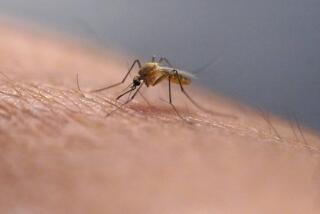They’re out for your blood
- Share via
They’re bloodthirsty parasites, waiting in the woods for unsuspecting victims to latch on to. Once they dig in, they stick like glue, gorging up to 50 times their body weight. A deadly disease can be transmitted through a single bite.
It may sound like a summer horror movie trailer, but it’s real life, and these bloodsuckers are in brushy areas right now in our local mountains. It’s tick season in Southern California.
These tiny monsters aren’t insects, but eight-legged arachnids closely related to spiders. They wait in low-lying brush for a warm-blooded creature to crawl onto, then jab their harpoon-like, barbed mouth parts into flesh, remaining firmly attached while feasting on the victim’s blood.
Ticks can transmit a host of diseases, including one that strikes fear in lovers of warm-weather outdoors everywhere: Lyme disease. It’s usually transmitted by nymphal ticks, which are poppy-seed-sized and hard to detect -- and abundant in the spring.
Symptoms begin a week or two after a bite, and early signs such as fever, body aches, headache and fatigue often go unrecognized. The debilitating disease is named for Lyme, Conn., where it was first reported in 1977. If untreated, weeks to months later victims may develop arthritis, neurological abnormalities and in rare cases brain inflammation.
There were 23,000 cases of Lyme disease reported in the U.S. in 2002, according to the Centers for Disease Control and Prevention. Most cases occur on the East Coast and in the Midwest, with some in northwestern California and Oregon.
A vaccine called Lymerix was taken off the market in 2002 after adverse reactions that included autoimmune arthritis. A vaccine does exist for dogs.
Luckily for Southern Californians, ticks are more of a nuisance than a health hazard. There were 97 cases of Lyme disease statewide in 2002, according to the California Department of Health Services, most in Mendocino County.
Despite occasional talk of Lyme disease in the local area, there were only eight cases reported in Los Angeles County in 2002, all of which were contracted by ticks outside the county. But ticks carrying the Lyme disease bacterium, Borrelia burgdorferi, have been reported in the county in the past. In 48 cases of Lyme disease since 1989, 16 were caused by L.A. County ticks.
A study by the state Department of Health Services in 2001-02 that analyzed about 900 Western black-legged ticks -- the species that transmits Lyme disease -- from the Santa Monica Mountains, Griffith Park and San Jacinto Mountains found no evidence of B. burgdorferi infection.
The disease is rare in the county because there are fewer Western black-legged ticks here compared with other tick species. Only 1% to 2% of the Western species is infected with the bacterium. Another factor in the lower incidence of disease may be the role played by the Western fence lizard, say researchers at UC Berkeley. The lizard’s blood contains a substance that kills the Lyme disease spirochete, a type of bacterium, according to professor of insect biology Robert Lane. So when a nymphal tick bites a lizard, it becomes cleansed of bacteria and can’t transmit it the next time it bites.
Ticks thrive in grassy, humid areas, such as the northern coast, and locally when vegetation is fresh in late spring and summer. Avoid hiking off-trail and be careful when sitting for a rest. A new study at UC Berkeley’s College of Natural Resources found that sitting on logs in forests was the leading cause of tick encounters, producing contact within five minutes in 30% of the cases.
Brushy trails in the Santa Monicas are tick hot spots, as are little-used paths along creeks in the San Gabriel Mountains. Stay away from game trails, because deer are ticks’ main transportation.
Hikers should do frequent tick checks on themselves and each other, recommends Maxine Dindia, a ranger at Malibu Creek State Park. Grasses are getting high at the park in Calabasas, says Dindia, and the ticks are out. She says park personnel are cutting back vegetation, which may reduce the odds of tick-human encounters.
Ticks crawl around on victims sometimes for several hours, seeking the perfect spot to embed, including necks, scalps and warm, hard-to-reach spots such as the groin, armpits and behind knees. Those with long hair should be extra careful.
Wearing light-covered clothing helps deflect ticks and tucking pant legs into socks prevents ticks from finding skin. Repellents with DEET can be applied to the skin and Permethrin on clothing.
The proper way to remove a tick, advises the Lyme Disease Foundation, is to use fine-point tweezers close to the point of attachment and pull the tick straight out. Forget folklore removal methods such as a burning match or gasoline because they can make the tick grasp on tighter.
Though ticks are a revolting annoyance, they’re a fact of life in Southern California -- and, with proper precautions and vigilance, not the fright-night film fare they may seem.
To e-mail Julie Sheer or read her previous Outdoors Institute columns, go to latimes.com/juliesheer.






